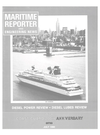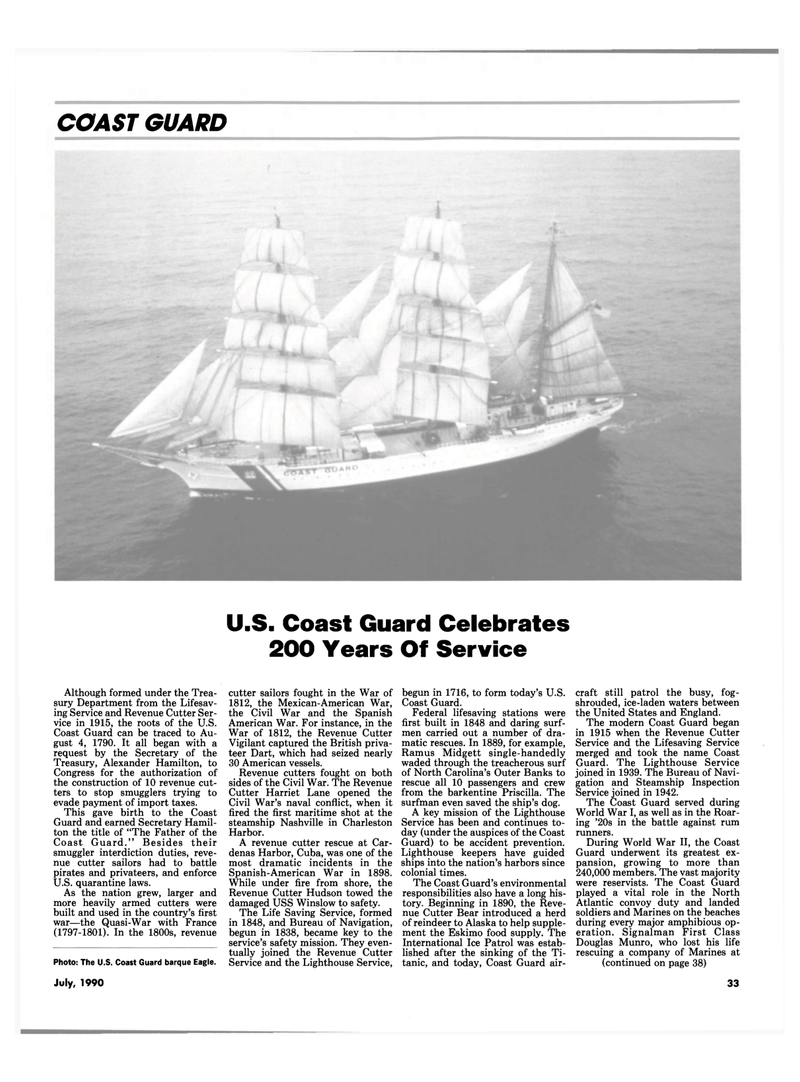
Page 36: of Maritime Reporter Magazine (July 1990)
Read this page in Pdf, Flash or Html5 edition of July 1990 Maritime Reporter Magazine
COAST GUARD
U.S. Coast Guard Celebrates 200 Years Of Service
Although formed under the Trea- sury Department from the Lifesav- ing Service and Revenue Cutter Ser- vice in 1915, the roots of the U.S.
Coast Guard can be traced to Au- gust 4, 1790. It all began with a request by the Secretary of the
Treasury, Alexander Hamilton, to
Congress for the authorization of the construction of 10 revenue cut- ters to stop smugglers trying to evade payment of import taxes.
This gave birth to the Coast
Guard and earned Secretary Hamil- ton the title of "The Father of the
Coast Guard." Besides their smuggler interdiction duties, reve- nue cutter sailors had to battle pirates and privateers, and enforce
U.S. quarantine laws.
As the nation grew, larger and more heavily armed cutters were built and used in the country's first war—the Quasi-War with France (1797-1801). In the 1800s, revenue
Photo: The U.S. Coast Guard barque Eagle. cutter sailors fought in the War of 1812, the Mexican-American War, the Civil War and the Spanish
American War. For instance, in the
War of 1812, the Revenue Cutter
Vigilant captured the British priva- teer Dart, which had seized nearly 30 American vessels.
Revenue cutters fought on both sides of the Civil War. The Revenue
Cutter Harriet Lane opened the
Civil War's naval conflict, when it fired the first maritime shot at the steamship Nashville in Charleston
Harbor.
A revenue cutter rescue at Car- denas Harbor, Cuba, was one of the most dramatic incidents in the
Spanish-American War in 1898.
While under fire from shore, the
Revenue Cutter Hudson towed the damaged USS Winslow to safety.
The Life Saving Service, formed in 1848, and Bureau of Navigation, begun in 1838, became key to the service's safety mission. They even- tually joined the Revenue Cutter
Service and the Lighthouse Service, begun in 1716, to form today's U.S.
Coast Guard.
Federal lifesaving stations were first built in 1848 and daring surf- men carried out a number of dra- matic rescues. In 1889, for example,
Ramus Midgett single-handedly waded through the treacherous surf of North Carolina's Outer Banks to rescue all 10 passengers and crew from the barkentine Priscilla. The surfman even saved the ship's dog.
A key mission of the Lighthouse
Service has been and continues to- day (under the auspices of the Coast
Guard) to be accident prevention.
Lighthouse keepers have guided ships into the nation's harbors since colonial times.
The Coast Guard's environmental responsibilities also have a long his- tory. Beginning in 1890, the Reve- nue Cutter Bear introduced a herd of reindeer to Alaska to help supple- ment the Eskimo food supply. The
International Ice Patrol was estab- lished after the sinking of the Ti- tanic, and today, Coast Guard air- craft still patrol the busy, fog- shrouded, ice-laden waters between the United States and England.
The modern Coast Guard began in 1915 when the Revenue Cutter
Service and the Lifesaving Service merged and took the name Coast
Guard. The Lighthouse Service joined in 1939. The Bureau of Navi- gation and Steamship Inspection
Service joined in 1942.
The Coast Guard served during
World War I, as well as in the Roar- ing '20s in the battle against rum runners.
During World War II, the Coast
Guard underwent its greatest ex- pansion, growing to more than 240,000 members. The vast majority were reservists. The Coast Guard played a vital role in the North
Atlantic convoy duty and landed soldiers and Marines on the beaches during every major amphibious op- eration. Signalman First Class
Douglas Munro, who lost his life rescuing a company of Marines at (continued on page 38)
July, 1990 33

 35
35

 37
37
